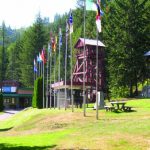Guest Editorial: Re-Zoning Not the Answer to Rossland's Water Woes
In the October, 2008 City Hall News, the need to re-zone an area of Topping Creek within the Creekside at Red development was identified. Under the current zone designation of “Open Space” (OS-1), there is no stipulation for a minimum development set-back from the creek. The planning department noticed that the present zoning designation is out of sync with Department of Fisheries and Oceans regulations and the current OCP (Official Community Plan)’s mandate to protect riparian areas. Thus, a new zoning designation, R-5 (resort-residential), was chosen.
The new zoning choice includes the caveat that no development can occur within a 15 metre buffer zone from the edge of any riparian areas. This matches the DFO’s minimum requirements for riparian areas. With this new designation the city can rest assured that they are not in contravention of the other regulations. The new zoning may protect the city from legal complications, but I would not go so far as to say that it adequately protects the watershed.
The proposed R-5 resort-residential zoning permits the construction of three-story buildings in the area, provided they are sufficiently far back from the creek. The riparian zone may be free from direct construction, but I would not consider it to be out of danger. The new zoning may be the first step toward opening the door to more development in the Topping Creek area.
Residential developments are far from environmentally neutral. Whether intentional or not, the new riparian zone restrictions come with an extra bonus for the developer, increasing the development potential of his land.
I found it hard to believe that this could be the only solution to the zoning dilemma, so I did some research on the relevant regulations. I also spoke to Rossland city planner Mike Maturo, DFO representative Bruce MacDonald, and Nelson’s city planner Dave Won. I am no expert; however, I do believe there are some alternative solutions worth considering.
Mike Maturo, the city planner in Rossland, was unable to provide me with the dimensions of the zone in question at the time I called. Thus, it is not possible for me to say whether it is large enough to even permit residential buildings. This is a question that needs an answer before we just hand the developer the zoning he’d likely prefer. Mr. Maturo emphasized the potential for confusion or even law-suits to arise if the zoning is left in its outdated state. When I asked him how many other areas in Rossland also have zone designations that are not in keeping with the regulations, he replied, “Tons”. He informed me that the city staff will be working to rectify some of the other problem areas over time. This particular property was identified as a priority to ensure protection the watershed.
Dave Won, the city planner in Nelson, was not familiar with our particular situation, but said that Nelson has struggled with similar issues of non-conforming zone designations. He informed me that out-dated by-laws are quite common, but it is very uncommon for city planners to decide of their own initiative to rezone a property. Why? Because it is too costly to take a piece-meal approach to solving zoning problems. Instead, his department generally makes changes after conducting periodic zoning reviews.
When a problem such as Rossland’s becomes evident, they are more likely to re-write or amend the offending by-law so that it will apply to all the non-conforming areas. So, for instance, Rossland could simply amend it’s “open” zoning bylaw to prohibit development in riparian areas.
Mr. Won also mentioned that the city has included specific riparian zone regulations in their OCP. The OCP clearly states that no development shall occur within 15 metres of any riparian area regardless of the zoning. This sounds great to me. There would be no ambiguity for any involved parties.
Nelson isn’t alone in adopting across the board riparian zone regulations. In fact, many areas of the province have much stricter ones. The lower mainland (except Vancouver), the Fraser Valley, and the Okanagan have all adopted the Riparian Zone Regulations. Under these regulations, no development can occur within 30 metres of a riparian area. The DFO representative for our area informed me that studies have shown that the 30 m buffer zone significantly improves fish health and survival rates as compared to the required 15 m minimum. Considering that this is the way other communities are going, it makes sense to strengthen and homogenize the water protection regulations before approving the final draft of our Official Community Plan.
To preserve and protect our riparian areas we need to have a plan that can be applied universally. If water protection truly is the motivation for the proposed Topping Creek zoning change, our council should be open to considering alternatives to the band-aid approach of re-labeling offending zones one by one. Consideration should also be given to raising the no-build buffer above the minimum 15 metres that is required for fish protection. After all, this is not just any fish-bearing stream we are talking about; it is our drinking water.
The draft of the OCP will be reviewed this Wednesday at the Miner’s Hall. Anyone who would like to see better protection for our water specifically written into the OCP should be there. The date for the rezoning of Topping Creek will be set during the Oct. 14 city council meeting.
Time appears to be running out. However, I think citizens need to make it clear that the OCP should not be rushed through before the important issue of water protection is fully addressed.






















